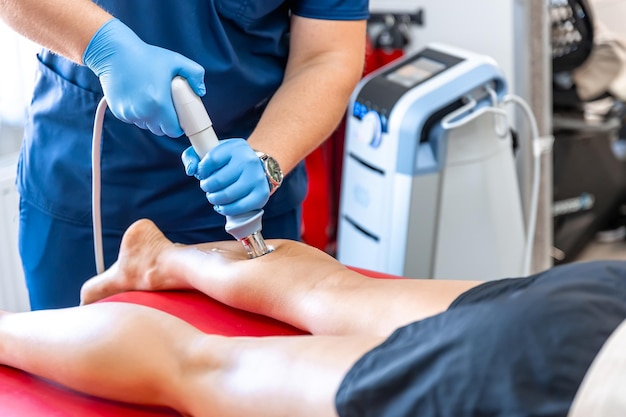Tendonitis can be a frustrating and painful condition, often interfering with your ability to enjoy daily activities or perform at your best. If you’ve been exploring treatment options, you may have come across shockwave therapy as a potential solution. But how does it work, and can it really help you recover faster? Let’s discuss how shockwave therapy is making waves in the world of tendonitis treatment.
What Is Shockwave Therapy?
Shockwave therapy, also known as extracorporeal shockwave therapy (ESWT), is a non-invasive medical treatment that uses high-energy sound waves to target injured tissues. Originally developed for breaking up kidney stones, the therapy has evolved to treat various musculoskeletal conditions, including tendonitis.
Here’s how it works: the high-frequency acoustic waves penetrate the affected area, stimulating the body’s natural healing processes. This includes increasing blood flow, promoting cell regeneration, and reducing inflammation.
What Causes Tendonitis?
Tendonitis occurs when a tendon—the thick, fibrous tissue that connects muscle to bone—becomes irritated or inflamed. It’s often caused by repetitive motion, overuse, or sudden injury. Common forms include:
- Tennis Elbow: Tendonitis affecting the elbow.
- Achilles Tendonitis: Pain in the Achilles tendon near the heel.
- Rotator Cuff Tendonitis: Inflammation in the shoulder tendons.
- Patellar Tendonitis: Often called “jumper’s knee,” it affects the tendon connecting the kneecap to the shinbone.
If left untreated, tendonitis can lead to chronic pain or even tendon rupture. This is why finding effective treatment is crucial.
How Does Shockwave Therapy Help With Tendonitis?
Shockwave therapy is gaining recognition for its effectiveness in treating tendonitis. But what makes it so impactful? Let’s break it down:
1. Promotes Tissue Regeneration
One of the primary benefits of shockwave therapy is its ability to stimulate tissue repair. The acoustic waves trigger the release of growth factors, encouraging cells to regenerate damaged tendons.
2. Increases Blood Flow
Poor circulation often hinders the healing process in tendons. Shockwave therapy enhances blood flow to the affected area, delivering more oxygen and nutrients essential for recovery.
3. Reduces Pain and Inflammation
Chronic pain from tendonitis is often linked to inflammation. Shockwave therapy has an anti-inflammatory effect, which helps reduce swelling and alleviate pain.
4. Breaks Down Calcifications
In some cases, calcium deposits form in tendons, leading to further pain and restricted movement. Shockwave therapy can break down these deposits, improving flexibility and reducing discomfort.
5. Non-Invasive with Minimal Downtime
Unlike surgery, shockwave therapy is a non-invasive treatment that doesn’t require extended recovery periods. Most patients can resume their daily activities shortly after treatment.
What to Expect During Shockwave Therapy
If you’re considering shockwave therapy, you might be wondering about the procedure itself. Here’s a step-by-step overview:
- Initial Assessment: Your doctor or physical therapist evaluates your condition and determines if shockwave therapy is the right option for you.
- Application of Gel: A gel is applied to the treatment area to facilitate the transmission of acoustic waves.
- Shockwave Delivery: A handheld device delivers the acoustic waves to the targeted area. The process typically lasts 15–30 minutes.
- Mild Discomfort: Some patients may feel slight discomfort during the treatment, but it’s generally well-tolerated.
- Post-Treatment: You might experience mild soreness or redness, which usually subsides within a day or two.
If you’re seeking professional treatment, we highly recommend visiting the Shockwave therapy specialists in Seattle at gainswave-washington.com. Their expertise in shockwave therapy ensures you receive the most effective and tailored care for faster recovery.
How Many Sessions Are Needed?
The number of sessions varies depending on the severity of your tendonitis. Most patients require 3–5 sessions, spaced about a week apart, to see significant improvements. However, some may notice benefits after just one or two treatments.
Is Shockwave Therapy Safe?
Safety is a top concern for anyone considering a new treatment. Shockwave therapy is generally safe when performed by trained professionals. It’s FDA-approved for certain musculoskeletal conditions and has minimal side effects, such as temporary soreness or redness in the treated area.
However, it’s not suitable for everyone. People with blood clotting disorders, infections in the treatment area, or pacemakers should consult their doctor before undergoing shockwave therapy.
Who Can Benefit from Shockwave Therapy?
Shockwave therapy is particularly effective for individuals who have tried other treatments, such as rest, physical therapy, or medication, without success. It’s ideal for:
- Athletes seeking to return to their sport quickly.
- Individuals with chronic tendonitis who want to avoid surgery.
- Anyone looking for a non-invasive, drug-free treatment option.
What Are the Advantages of Shockwave Therapy Over Traditional Treatments?
While options like rest, anti-inflammatory medications, and physical therapy are often the first line of defense, shockwave therapy offers unique benefits:
- Faster Recovery: Stimulates quicker tissue repair compared to conventional treatments.
- Non-Invasive: No incisions or anesthesia required.
- Drug-Free: Reduces reliance on painkillers or anti-inflammatory drugs.
- Long-Lasting Effects: Many patients experience lasting relief after completing their sessions.
Are There Alternatives to Shockwave Therapy?
If you’re exploring all your options, other treatments for tendonitis include:
- Physical Therapy: Focuses on strengthening and stretching exercises.
- Corticosteroid Injections: Provides temporary relief by reducing inflammation.
- Platelet-Rich Plasma (PRP) Therapy: Involves injecting concentrated platelets to promote healing.
- Surgery: Considered a last resort for severe or chronic cases.
Each treatment has its pros and cons, but shockwave therapy stands out for its ability to address the root cause of tendonitis without invasive procedures.
Final Thoughts: Is Shockwave Therapy Right for You?
If tendonitis is affecting your quality of life, shockwave therapy could be the solution you’ve been searching for. Its ability to speed up recovery, reduce pain, and enhance overall function makes it a compelling option for many.
Let’s discuss—have you tried shockwave therapy for tendonitis, or are you considering it? Share your experiences and thoughts. It’s time to take the first step toward a pain-free life!
Shockwave therapy is transforming how we approach tendonitis treatment, offering hope and healing to those ready to move beyond pain. Why not see if it’s right for you?









